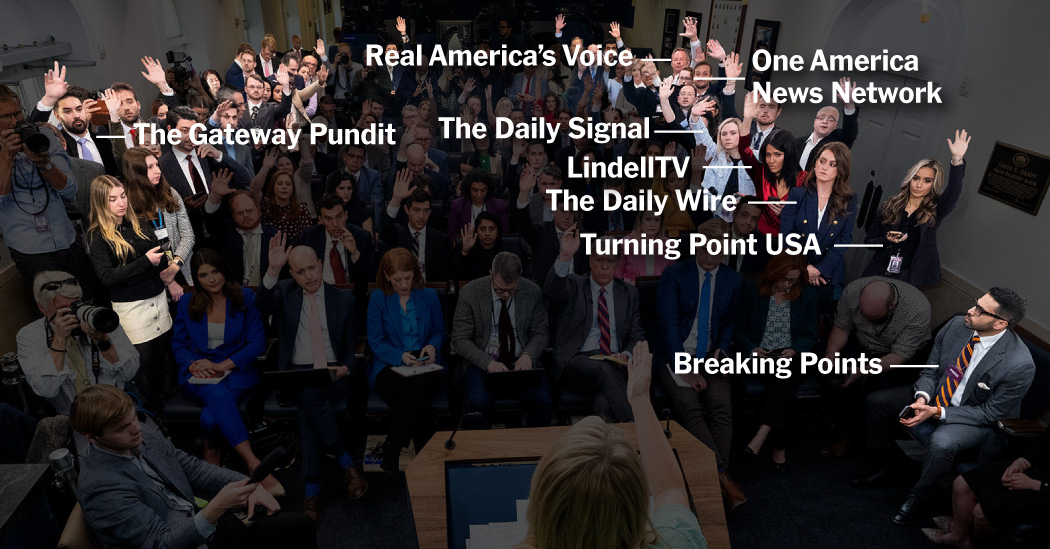Built on top of an old swimming pool in the West Wing, the James S. Brady Press Briefing Room allows journalists to question the administration on its policies and the news of the day, while press secretaries get a chance to put a positive spin on the president’s agenda. A combination of hard-hitting questions and the occasional softball ones from journalists have always been part of the mix.
During Mr. Trump’s first term, the administration’s primary method of controlling the briefings was to hold them very rarely. This time, the administration has made moves to insert itself into the day-to-day workings of the press corps that covers it.
The White House has handpicked news media outlets to participate in the presidential press pool. In the briefing room, officials have made room for a new cohort of more partisan attendees, like right-wing podcasters, who often ask less-adversarial questions than traditional journalists. The White House has said it is adjusting the makeup of the press that covers it — both in and out of the briefing room — to better reflect the outlets where people consume news and information today.
Longtime White House reporters say the result has been an erosion of their independence. They say the increased attention toward pro-Trump media personalities, who rarely challenge the administration’s talking points, has undercut the briefings as a space to relay accurate information to the American public and hold the president to account.
The room’s seating chart reflects a news outlet’s perceived importance. Journalists who sit in the front rows typically have more of their questions addressed by the press secretary. By planning to reorganize the seating chart, the White House could continue to lessen the influence of large legacy news organizations and boost newer and often more partisan media outlets that have shown support for the administration’s policies.
Current briefing room seating chart
In January, Ms. Leavitt announced in her debut briefing the addition of a permanent “new media” seat. This seat, stage right of the lectern, is reserved for someone the White House selects from a nontraditional outlet, ranging from digital upstarts like Axios and Semafor, which strive for independent reporting, to partisan influencers and YouTube stars. Guidelines for selection to occupy this seat remain vague. (Ms. Leavitt said in a February briefing that her office was sifting through more than 12,000 applications.)
‘New media’ seat occupants
These lead-off questions have ranged from topics like artificial intelligence to foreign policy to the economy, and many of the inquiries were relatively impartial. But a few seat occupants have framed their questions with an angle that is critical of independent media or Democratic lawmakers in Congress.
The videos below show the mix of questions from the “new media” seat.

Immigration
John Ashbrook
Ruthless Podcast

Trans athletes
Sage Steele
The Sage Steele Show

Federal workers
Shelby Talcott
Semafor

Economy
Saagar Enjeti
Breaking Points
Media outlets with preferred seating have been called on the most often across all of Ms. Leavitt’s 15 briefings so far: CNN, Fox News, ABC News, The New York Post, CBS News and NBC News have been called on at least 11 times each. Most others in the room may not be called on in a typical briefing, but more time is being given to those sitting in the back rows or standing along the perimeter.
Some of those along the perimeter have asked questions more favorable to the administration or have echoed right-wing talking points. Mary Margaret Olohan, of the conservative site The Daily Wire, has been called on seven times, once as the occupant of the “new media” seat. Jordan Conradson, of the pro-Trump outlet The Gateway Pundit, and Daniel Baldwin, of the right-wing One America News, have each been called on five times.
Other notable figures along the perimeter are Monica Paige Luisi, who works for Charlie Kirk’s Turning Point USA; Brian Glenn of the right-wing outlet Real America’s Voice, who is dating Representative Marjorie Taylor Greene, the Republican of Georgia; and Cara Castronuova, who works for LindellTV, a media outlet founded by Mike Lindell, the Trump loyalist and MyPillow magnate.
Here is a sampling of their questions, from four different briefings.

Deportation efforts
Jordan Conradson
The Gateway Pundit

Trump’s agenda
Daniel Baldwin
One America News Network

Deportation videos
Mary Margaret Olohan
The Daily Wire

Trump’s health
Cara Castronuova
LindellTV
Reporters with assigned seats typically arrive in the briefing room just a few minutes before the event begins. But those without seats often arrive more than an hour beforehand, to claim space on the crowded perimeter of the room.
Below, you can scroll through a timelapse of the 75 minutes before the start of the press briefing on March 26. The briefing took place two days after the editor of The Atlantic disclosed that he had been added to a private conversation on Signal among top Trump administration officials as they weighed plans for U.S. strikes on Houthi targets in Yemen.
This day’s briefing was shorter than most, lasting only about 25 minutes. Ms. Leavitt began by talking about investments made by private and international companies in the United States. She repeated the administration’s assertion that no classified information had been exposed in the Signal chat.
Ms. Leavitt then called on nine people for questions. The only question not about Signal came from Ms. Castronuova of LindellTV, who was standing along the perimeter. “Why are Democrats so against election integrity measures, like obviously, proof of citizenship,” she asked, “when it comes to voting in the United States election?”
Notes
The photo at the top of this article is from a press briefing on March 12. The video clips used throughout are from The White House, ABC News and The Daily Wire.
